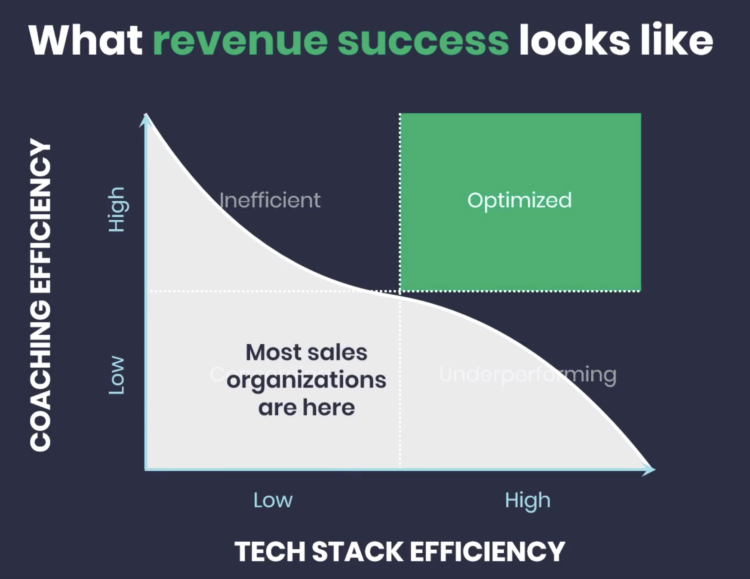On Tuesday, June 14th, CNBC reported we officially entered a bear market with equity markets down 20% or more from their most recent all-time high. The market setback has top CEOs preparing for a recession, with 60% of business leaders expecting the economy to worsen over the next 6 months.
Now more than ever, businesses must shift focus to growing revenue and increasing profitability. But how? Typically, there are three ways to do this:
- Hire more salespeople
- Increase productivity of existing salespeople
- Decrease spending per sales rep
In a recession, few companies will go the route of hiring more salespeople. Here are tips to increase sales rep productivity and decrease spending per rep instead.
Sales Coaching Increases Rep Productivity
To grow the business during a recession, you must increase sales productivity. The most successful revenue teams understand the value of sales coaching programs and use them to close skill gaps and increase revenue generated per rep.
Sales Productivity = Revenue / # of Reps (what you need to increase during a downturn).
Increasing rep productivity starts with sales coaching. And organizations that measure competency improvement as a coaching metric notice an average rep quota that is 7% higher than those that do not.

Consider the following best practices when developing and operationalizing your sales coaching program:
- Document your sales methodology
- Align on what “good” looks like
- Leverage different coaching modalities to address different skill gaps
- Capture conversations & automatically surface coachable moments (or good calls)
- Develop coaching plans based on rep skill gaps
- Monitor rep performance to assess coaching effectiveness
- Make staffing decisions based on coaching data & rep progress
How to Build a Successful Sales Coaching Practice with Conversation Intelligence
There are six crucial steps to building a successful coaching program:
Step 1: Each week, have the sales rep identify two calls: one where they struggle and one that they thought went well.

Step 2: Have the sales rep pull recordings, listen and comment on what worked and what didn’t.
Step 3: The sales rep shares the same two calls with their manager.
Step 4: The manager listens to the calls and reviews the sales rep’s comments.
Step 5: The manager provides additional comments on each call.
Step 6: The sales rep and manager allocate 20-minutes during their one-on-one call for call-level sales coaching and use our proven formula to drive improvement:
- The rep self-assesses.
- The manager leads with something positive.
- The manager focuses feedback on one or two things.
- The sales rep practices.
- The manager tracks progress.
Using this formula to build a coaching program will drive consistent, positive results for sales reps. By sticking to these steps, you will start to see a change in the reps’ behavior that will lead to better sales performance.
Improve Sales Efficiency to Drive More Revenue
Consider the following:

Optimized coaching and tech stack efficiency are key to business growth, but most sales organizations find themselves somewhere in the white zone shown above. Maybe they have the right tools but haven’t coached their reps to use them and suffer from low adoption. Perhaps, they’re spending enormous amounts of energy coaching reps but haven’t invested in tools that could take them to the next level. Or they’ve invested in too many point tools and added a layer of complexity to the sales process that holds reps back or prohibits them from achieving their goals.
Success is having high coaching efficiency (which leads to increased rep productivity) and high tech stack efficiency (resulting in less cost per rep).

What types of tools do reps and managers really need to be successful? Sales enablement, content management, conversation intelligence, and forecasting tools (to name a few) can give your team an edge. But consider deploying one or two solutions that bundle these capabilities together to improve adoption and get the most bang for your buck. Having all of the activity and engagement data captured by these solutions in one place will help you take your sales organization to the next level.
Use Data To Create Change
Data allows you to create the most business impact with the fewest coaching calories burned.
How long does the rep spend on each call? How many of those calls lead to meetings? How many of those meetings lead to closed deals? How long do those deals stay in the pipeline? What content was shared during the calls and did that content speed up or slow down the deal progression?
If you don’t have access to the answers to the above questions, you’re missing signals that could help you uplevel reps and sales practices to get deals over the finish line. It’s not just about conversations and sales training. There are many things to consider when looking at rep behavior such as email activity, contacts, content shares, the content presented, value assessments, and intent. It is important that a coach looks at every angle to understand rep behavior and performance.
When the coach is receiving data from performance and pipeline data, content and engagement data, and conversation intelligence data, that is when the coach sees the full picture, and real behavior change occurs.
To learn more, watch our recent webinar on Growing In A Recession: 6 Steps to Sales Coaching Success.

Comments are closed.